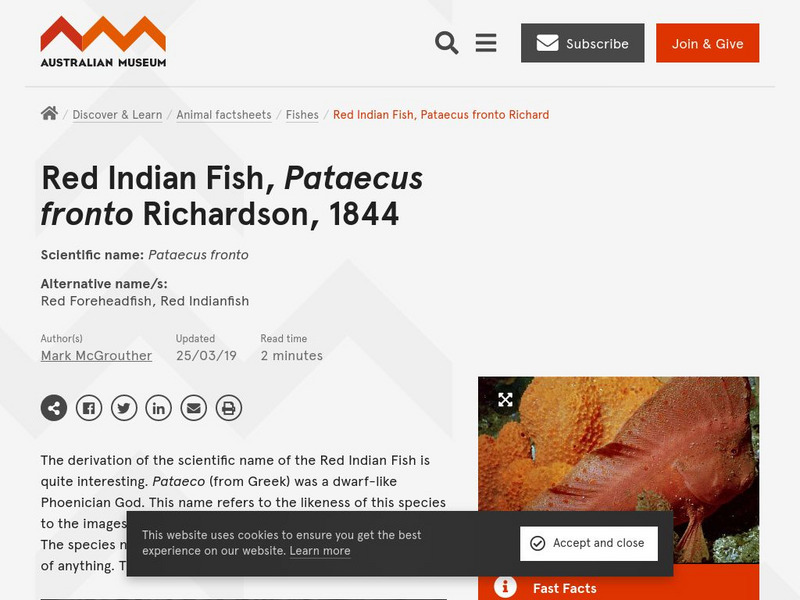Curated OER
Testing the Waters
Eleventh graders examine a local body of water. In this science lesson, 11th graders collect water samples to test. Students analyze the data and make conclusions. Students create tables and graphs of the data.
Curated OER
Tree Leaves: Determining the Characteristics They Share in Common
Students use their basic knowledge of dendrology concepts and terms. In this tree leaf lesson students divide into groups and determine which characteristics go with what plant.
Curated OER
Getting to Know Some of Pennsylvania's Fishes
Students research and identify the fish of Pennsylvania. In this earth science lesson, students view ten photos of fish and identify the characteristics of each fish. Students record observations and practice naming the fish using their...
Curated OER
Digital Wildflower Collection
Students examine biodiversity and classify organisms. In this wildflower lesson students go out and take pictures of plants then create a presentation to show the class.
Curated OER
Supermarkets, Sustenance and Sustainability
Students investigate jungles and the people who depend upon them. In this sustainability lesson, students research wild life conservation and discover the importance of a jungle to Amazonian people. Students create a group...
Curated OER
Animal Games
Students explore a variety of games on the Internet that will teach them about animals; they focus on the Florida panther. Students choose the activity that is of interest to them, and then rotate between the games online and the...
Curated OER
Critter Characteristics
Students explore the adaptations of deep sea life forms. In this science lesson, students watch a video to observe characteristics which allow for the sea creature to thrive in it's environment. Students determine the physical,...
Curated OER
Wisconsin Birds Lesson Plan
Students, during an outdoor hike, are taught about the different types of birds found in Wisconsin.
Curated OER
The Story that Tracks Tell
Eighth graders observe and investigate animal tracks. They draw prints for local animals and switch with another student to guess the animal, identify animal tracks in a nearby wood lot, create plaster casts of the tracks, and write a...
Curated OER
Finding and Collecting in the Field
Students examine the types of plants brought over to America from immigrants. They research how some of these types of plants cause damage and alter the landscape. They record data and share the information with the community.
Curated OER
Tagging Race
Learners examine and identify plant parts to recognize specific weeds, identify three different weeds, discern differences in weeds quickly, evaluate classmates' weed recognition, and discuss what strategies they used to identify weeds.
Curated OER
Amazing Bird Adaptions--Why Am I A Bird?
Fourth graders identify and classify birds found in Illinois. Using the internet, they discover how birds have adapted over time and how the adaptations have increased their life span. They compare and contrast the various adaptations...
Curated OER
You Are Where You Live
Students explore where insects live and how they have adapted to their environment.
Curated OER
DNA the Easy Way (and "Gram Stain" Without the Mess)
Pupils visualize DNA from cells and explain the basis and importance of the Gram-stain reaction and to perform the KOH test equivalent.
Curated OER
You Are Where You Live
Third graders observe insects in a number of habitats. They recognize which insect characteristics are adaptations to their habitats.
Curated OER
Biological Sampling Device Using a Sea Perch
Students construct plankton nets to be towed and collect specimens to be examined and analyzed in the classroom. They develop research skills through collection of an aquatic sample. They write lab reports after interpreting, identifying...
Curated OER
Classification of Organisms
For this classification worksheet, learners complete a crossword puzzle with 17 clues about vocabulary pertaining to the classification of organisms.
Curated OER
Classification of Organisms Crossword Answers
In this classification worksheet, students are provided with the answers to a crossword puzzle which has 17 clues pertaining to classification of organisms vocabulary.
Curated OER
Nothing Goes to Waste Here: Saw Mills in Action
Students examine lumber mills operate and their efficiency. In this saw mill lesson students view a PowerPoint presentation then feel different grades of lumber to see how rough sawn lumber is.
Curated OER
Water Quality Survey: Monitoring the Sustainability of Pigeon Creek
Students research the History of Pigeon Creek (or any watershed in your area). In this environmental science lesson plan, students conduct field tests such as pH and nitrates. They collect data and compare what they collected with other...
Canadian Museum of Nature
Canadian Museum of Nature: Bird Identification Clues
This resource will help you develop your birdwatching skills. It includes how to find birds, basic tips and how to use field marks such as patterns and colours to help distinguish species.
Australian Museum
Australian Museum: Animal Species: Red Indian Fish, Pataecus Fronto
A description of the Red Indian Fish, which lives only off the coasts of Australia. Description includes identification, habitat, feeding and diet, as well as other characteristics or qualities of the species.
University of Michigan
Michigan Sea Grant: Teaching Great Lakes Science: Fish Identification
For this lesson, students examine the physical characteristics of fish that live in the Great Lakes and identify common features that help species to survive in that environment. Downloadable resources include a fish poster, fish family...
Genome British Columbia
Genome British Columbia: Dna Goes Upc: An Introduction to Dna Barcoding
In recent years, Canadian scientists have been in the forefront of efforts to identify animal species by DNA barcoding. A single gene, cytochrome oxidase I (COI), that is present in all animals is being used to identify each species....























